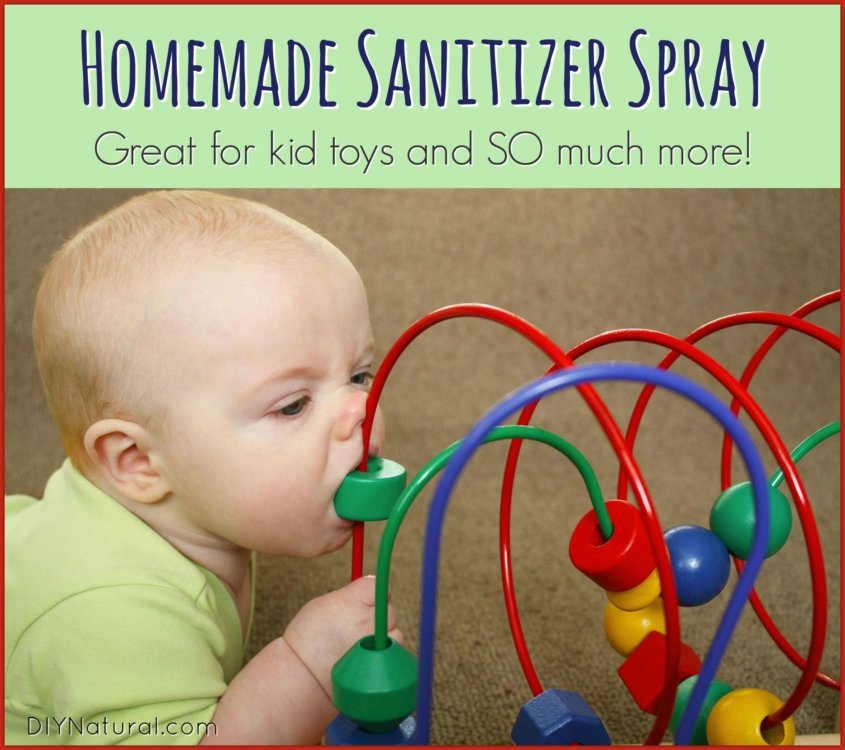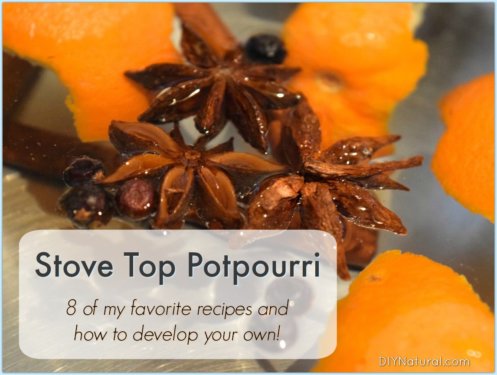
We a make a big bottle of this natural homemade sanitizer spray for use as a DIY disinfectant and everyday cleaner. It’s safe and it works.
A Homemade Sanitizer Spray!
Before I had children I was a preschool teacher. It was one of my favorite jobs because I was able to spend all day teaching and playing with a wonderful group of kids.
There was only one downside: germs.
Preschools are notorious for being full of germs, and with good reason. Imagine a room that is visited by over 60 different children each week who carry various germs from their families, playgrounds, and everywhere else.
Now imagine all those germs collecting on toys, carpets, tables, dress-up clothes, and other surfaces. That’s a lot of germs!
Per childcare guidelines, I had to sanitize all the toys in the room at least once a week. It was definitely the least favorite part of my job. Sanitizing meant gathering a 5-gallon bucket filled with a 1:4 part mixture of bleach and water and dunking or spraying all toys and surfaces in my preschool room. I was unable to open the windows, so the room was full of bleach fumes. Additionally, all the toys would smell like bleach for days after being cleaned.
Needless to say, when I became a mom, I wanted to make a natural homemade DIY disinfectant spray to clean my kids’ toys. It’s amazing how quickly our family accumulates toys and how they become dirty even more quickly!
Methods for Naturally Cleaning Toys
We try to avoid bleach around our home as the fumes and chemicals can really do a number on our health. Instead, we mainly use natural cleaners, like homemade sanitizer spray, to help get rid of germs. There are three methods I employ to get our toys clean. I sanitize them in boiling water, in the dishwasher, or I make my own DIY sanitizing spray. Each method works for different types of toys. I’ll show you how and why below.
Sanitize Toys in the Dishwasher
This is one of the easiest methods to clean toys! If your dishwasher has a sanitize feature you can easily wash germs away.
The Method: Simply place toys in a dishwashing container or lingerie bag on the top rack of the dishwasher. Wash on the normal sanitize cycle with a small amount of natural dish detergent. (You can learn how to make your own DIY dishwashing detergent here)
This method works for non-electronic hard plastic toys (that are heat resistant), action figures, toy cars (heat resistant plastic or metal), etc.
Boil Toys
If you don’t have a sanitize option on your dishwasher, and don’t want to make homemade sanitizer spray, some toys can be boiled. Boiling is ideal for toys that come into contact with the baby’s mouth because it doesn’t require any detergent. This method mainly applies to toys that won’t leech toxic chemicals when heated. Softer plastic toys often cannot be boiled for this reason.
Check on the back of the box or the tag of your toy to see if they can be boiled. Most toys will indicate one way or the other.
The Method: bring 1-2 quarts of water to boil in a large stockpot. Turn off heat. Submerge toys for 5 minutes and then remove carefully with a utensil (I use salad tongs). Place on a cooling rack to air dry.
This method works for: pacifiers, hard plastic toys, silicone toys, baby bottles
Homemade Sanitizer Spray
This DIY disinfectant sanitizer spray is what I use for everyday cleaning and sanitizing. We have a lot of child toys so I keep a big bottle on hand. It is natural and safe while still doing a great job of cleaning toys and much more.
Ingredients
- 1 cup distilled white vinegar
- 1 cup distilled water
- 30 drops lavender essential oil (find pure organic lavender EO here)
Instructions
- Combine all ingredients in a large spray bottle.
- Liberally spray toys and allow the mixture to sit for 1-2 minutes.
- Wipe clean with a damp cloth and allow toys to air dry.
Notes
This homemade disinfectant spray works for all toys that can tolerate being sprayed with water. For electronic toys, I spray a cloth with the sanitizing spray first and then wipe toys.
What did you think of this homemade sanitizer spray?
*******




The problem I find with vinegar (distilled, adding water, AND an essentials oils are
1. The vinegar scent STILL lingers, even after something is dry (dishcloths especially). Am I getting the ratio incorrect? I followed the recommended ratio on this site and it still smells of viniger
2. I’m not sure which oils are safe for cats and plants when using something as an all purpose cleaner/deodorizer
3. I’ve been using 91% isopropyl alcohol with dried lavender/lavenders oil or Basil. Cheaper that vodka and still evaporates (of course I also have no kids, which makes it easier.
/forgive me if I’m cross posting about disinfecting and freshening. This is my first time posting.
Many thanks,
Otter
I also use the Isp. alcohol w/dried lavender or dried mint and it is awesome and cheaper than using vodka for sure. I thought I was the only one doing it this way. You got this one nailed.
I use hydrogen peroxide with a sprayer top. I add lavender, lemon, and peppermint eo’s. I ‘m pretty sure the idea came from this site. I don’t have little ones and toys anymore, but this works great as a general cleaner and sanitizer. Just be sure not to get it on dark fabrics, as it can discolor them!
I make my own version of the 4 thieves oil for using to ‘disinfect’ all things. I use three drops in my sink when washing dishes, 5 drops in a load of laundry, two on a rag to wipe counters, etc. (this is the Neat version without added carrier oils) I have an undiluted (Neat) bottle under the sink and also have a few bottles of a diluted mix (2 TBSP carrier with 12-30 drops or 1tsp carrier with 5 drops) I just shake before spraying. This works great! It is a bit spendy to make, but I have an 8 oz bottle that I have been using for quite some time that is still nearly full. You take 1 oz each (or 1/2 oz., if you don’t want to make this much) of the following essential oils:
Clove, Lemon, Bitter and Sweet Orange, Rosemary, Cinnamon Bark, and Eucalyptus. If you like the smell of Tea Tree, you could also add that, but I don’t really like its smell, and it is a strong smell that would overpower the others, so I don’t use it. You don’t need all of these oils, but I have built up quite a good variety, and the smell is so delicious, so I used all of them.
Would just straight up white vinegar work? I put a few citrus peels in the spray bottle and cover with vinegar for cleaning kitchen surfaces, etc. Works great on the stove top as it cuts grease great!
Thanks!
I use vodka in place of white vinegar. Vodka is alcohol which evaporates quickly and does not cause the dermatitis I get immediately from vinegar.
Great idea! However, this spray is an alternative for those who do not wish to use alcohol on products that may end up in children’s mouths.
Diane, I just read your, “vinegar and dermatitis”. I am a big time vinegar user and never associated it with vinegar. Please explain in more detail. Thank you for this enlightening.
I like to use hydrogen peroxide. I buy the bottles at Costco then replace the lid with a squirter from a used up spray bottle.
I clean at a doctor’s office and the kids’ toy section has a cute, old wooden train set, a doll house with tons of little pieces of furniture and folks, etc. Books and kid size table and chairs. It would be impossible to clean each piece properly so the hydrogen peroxide is the next best thing!
Other great essential oils to use to naturally clean surfaces & objects would be Tea Tree or a citrus!
Totally! However, not all oils are safe to use around children, especially those under 2 years of age. Make sure to research the oils you choose first.
Just wondering, do you need the lavender for disinfecting, or is it to just add a nice scent?
Lavender essential oil adds to the disinfecting properties because it helps kill bacteria and viruses. However, the spray will still work well without it.